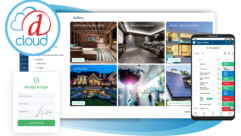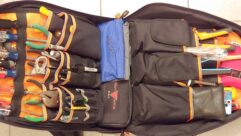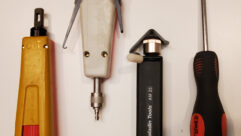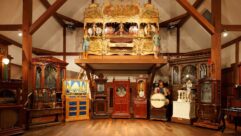Consultant’s Connection: Making Useful Tools Usable
There is a difference between AV tools that are useful and those that are usable by most professionals.
I recently spent an afternoon at a local game developer’s audio recording studio, making some acoustical measurements and looking over the engineer’s shoulder as she recorded some vocal tracks for a new game. Although I was there to ferret out some acoustical problems they were experiencing with their voice booth, I found myself observing life on the bridge between the analog and the digital realms.
The signal chain was pretty simple — a Neumann microphone connected to an analog pre-amplifier that fed a UREI LA-8 compressor/ limiter. The comp/limiter then fed a Pro Tools rig, which recorded a file to a hard drive hidden somewhere in the main distribution frame (MDF) room. Add some headphones, a power amplifier, and a pair of loudspeakers. What piqued my interest was the facility with which the engineer operated in both the digital and analog realms, almost simultaneously. Once basic levels were set, there were some minor adjustments and tweaking that she made to the compressor while recording tracks to the computer. This usually took no more than a few seconds to accomplish as we watched the levels bounce around on the Pro Tools digital meters. As she clamped down on the talent’s vocal levels, the engineer brought up the output level feeding the DSP and hard-disk recorder.
She could have done all of this processing in Pro Tools, but chose not to. Why? What was there about this old analog signal processor that she was so enamored with? Oh, one interesting side note — the engineer was under the age of 30. I found this to be significant given the ease with which younger generations have adapted to working in the digital realm.
As I explored this issue, I found that it came down to the question of usefulness versus usability. I often find myself examining a new piece of gear that appears eminently useful on the surface, but is not very useable.
What does that mean to us? The dictionary defines “useful” as being of use or service; serving some purpose; advantageous, helpful, or of good effect. It also states something is “usable” if it is available or convenient for use. It has everything to do with how easy it is for someone to grasp the purpose and operation of a tool and their ability to effectively use that tool (whether for its intended purpose or not).
There is no doubt in my mind (or my fingertips) that both analog and digital tools can be both useful and usable. With the maturation and ubiquity of the computer, we can now do things in the digital realm that we could not have done as easily as in previous decades. Take, for example, systems design. Not so long ago, making a change either to system signal flow or signal processing would have entailed additional time reworking drawings. Today, all you show are wiring connections in and out of a block; all the real work is done electronically, inside that block you just added to the drawing using CAD. Even after you’ve added the block, the work is not complete — the signal flow and processing must still be designed.
In many ways, designing with DSP is considerably easier to do and to change. In the past, there could be considerable additional expense to the owner in the form of materials and labor to make changes to a system design. It was not something you did without a great deal of thought. Today, this can be accomplished with relative ease by adding a new processing block and moving some images around on screen. Upload the file and reboot the DSP. The cost is considerably less.
In this context, the usefulness of DSP is that it solves a problem in a manner that could best be accomplished in the digital realm. In the past, either the application called for an analog solution that would have been prohibitively expensive — limiting the number of devices that could be sold at a profit — or the available technology wasn’t able to perform in the required manner. DSP allows you the ability to make endless changes to the system design at the time the system is installed, which can be both a blessing and a curse.
Let’s get back to my example. The analog comp/limiter is both a useful tool and extremely usable, but not just in this situation only. It is useful and usable in every situation. It does the job we expect of it with very little thought or concern, once we know how to operate the tool properly.
While DSP is useful (Pro Tools in this case), it is not necessarily usable. It takes a while to learn. Adjusting any of the plug-ins or standard programming blocks is not as easy as it could be, as it was with that analog compressor the engineer was playing with. Pro Tools was extremely helpful when she needed to lay down a variety of tracks and be able to combine them into a dialog sequence. This has made it much easier and cheaper to stitch various pieces together into a cohesive whole.
We still have a long way to go. DSP has not reached the same level of usability as analog technology. The beginnings of our industry were forged in the basic research in human auditory response, loudspeaker design, speech intelligibility, and human interface factors. We don’t often stop to think of the contributions of Bell Labs, Western Electric, and a host of others that performed the research and figured out how humans interact with their tools. In the computer realm, XEROX SPARC did the same for many of the ideas that we now take for granted in the computer industry. Audio DSP manufacturers need to build on that legacy and perform new research into human factors that will turn useful DSP systems into usable ones that will be embraced by the end-user.
While everyone has their own (and better!) mousetrap, there are some aspects of DSP programming that could be standardized between the available offerings. These include how computers connect to the DSP controllers, whether the same program must reside on both the computer and the DSP, how signal processing controls operate, and updating firmware, etc. I know how difficult such standardization can be, but I think it is a vital step that must be taken before the industry can really move forward.
As an example of what can be done, we need look no further than InfoComm International’s “Dashboard for Controls” initiative. In the mind of many users, the control panel in a typical AV system is the system. If the interface doesn’t work, the system doesn’t work. Dashboard was envisioned as a means to provide a level of standardization for designers, programmers, and end-users. The Independent Programmer’s Council, in conjunction with consultants and contractors, has been hard at work on the Dashboard for Controls. They deserve much credit for the product they have created to help define and standardize this interface for the corporate or educational user. They recognized a common problem and started working on a common solution.
Just as the controls industry has begun to incorporate “usable” interfaces with a “useful” product, the pro audio industry needs to move in the same direction with DSP systems. How will people use these devices? How can we (manufacturers, system designers and integrators, and end-users) improve that experience and reduce frustration? Although I’m not a Luddite on most days, there are days when I really do prefer a knob to a mouse.
Thom Mullins is a senior consultant, specializing in systems design, with BRC Acoustics & Technology Consulting. His e-mail address is [email protected].
FEEDBACK
To comment on this article, e-mail the Pro AV editorial staff at [email protected].










